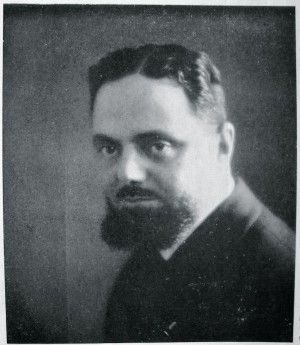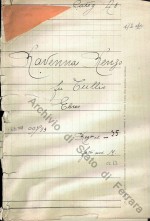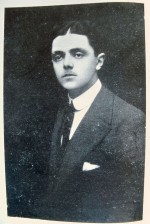Renzo Ravenna (Ferrara, 1893-1961)
Renzo Ravenna was Podestà of Ferrara from 1926 to 1938. A friend of the Quadrumvirate member Italo Balbo, he was not only the first Italian podestà of Jewish origin, but also the only Jew to have played this role during Fascism.
1. The Lawyer
Renzo Ravenna was born in Ferrara in 1893 into one of the oldest families in the Jewish community.
He started technical school, but then convinced his father to enrol him in the Ariosto High School. Between Piazza Ariostea and the Palestra Ferrara he met and made a deep friendship with the young Italo Balbo, future hierarch of Fascism.
In 1912 he enlisted as a volunteer and the following year enrolled in the Faculty of Law of Ferrara. In the period preceding Italy's entry into the war in 1915, Renzo Ravenna, like many of his peers, is a convinced interventionist and once called to the front he quickly climbed the military hierarchy thanks to his skills and his marked practical sense. Back in 1919, he graduated in law and began to practice as a civil lawyer specialising in commercial law. From the 1920s he held increasingly important public positions and became the secretary of the ANC, the National Combatants Association.
2. Adherence to Fascism and the appointment of Podestà
Renzo Ravenna joined the National Fascist Party in 1924, but already in the 1920 elections he was among the candidates of the National Bloc. His can be considered an example of that social grouping formed by the small and medium urban bourgeoisie, without distinction between Jews and non-Jews, which clings to the regime. To this must be added the component of friendship that bound him to Italo Balbo.
Between October 1925 and the summer of 1926, Renzo Ravenna followed Italo Balbo, now Undersecretary of the National Economy, to Rome. While he was in the capital, the law that replaced the elected local administrations with the appointment of the Podestà is approved: a figure who remains in office for 5 years and centralizes all the functions of the mayor, the junta and the municipal council, appointed by royal decree on the proposal of the Prefect to the Ministry of the Interior.
Renzo Ravenna was immediately the candidate for Ferrara, also because in 1926 the prefect received a letter in which Balbo expressed the will "of Ferrarese fascism for me to appoint Commendator Renzo Ravenna", the only one he could rely on after the Matteotti murder because "Ferrarese fascism does not crumble" (Pavan 2006, p. 47). It is at this juncture that mention is made for the first time of his religious affiliation, as a matter to be resolved. Renzo Ravenna was in any case appointed Podestà by Royal Decree on 16 December 1926: he was the first of Jewish origin and the only Jew to have held this role.
3. The Jewish Podestà
Renzo Ravenna, once installed, did not purge the administrative staff, making the policy of his management clear: prioritize professionalism over political affiliation.
His administration was characterised by an extensive programme of public works and the cultural promotion of the city. The architect Ciro Contini played a fundamental role in this extensive work of urban redevelopment. In those years, the National Archaeological Museum of Spina, the Opera del Duomo Museum and the museum dedicated to Boldini were established, all as part of a policy aimed at enhancing belonging to the city through the recovery of its history and traditions. The Podestà Renzo Ravenna was also responsible for the creation in 1933 of the famous exhibition on Ferrara painting of the Renaissance that inspired Roberto Longhi's essay "The Ferrara Workshop".
In 1934, however, the chief of staff of the Ministry of the Interior, representing Mussolini himself, asked to replace Renzo Ravenna with a Catholic mayor, as the citizens would be unhappy to have an Israeli mayor. Renzo was defended by Italo Balbo and by the Prefect himself and reconfirmed in his role at the end of his mandate in 1935.
The situation deteriorated in 1938: in March of that year, a few months before the official start of the racial persecution, Renzo Ravenna was forced to give his ‘spontaneous’ resignation: all the city authorities, ecclesiastical, political and public, participated in the ceremony with which he left office, demonstrating the esteem and respect of the citizens.
4. Escape to Switzerland
With the enactment of the Racial Laws, Renzo Ravenna's private and professional life did not undergo particular changes, also because in 1939 his request for discrimination was accepted, extended to his wife and children.
The watershed for the Ravenna family was 8 September 1943: they had already moved to the countryside for some time, less subject to bombing; the German occupation and the establishment of the Social Republic led them to choose the escape route to Switzerland.
On 20 November they reach the border and were taken to a collection camp near Bellinzona. Renzo Ravenna and his son Paolo were separated from his wife Lucia Modena, who remained with their two youngest children, and taken to different refugee camps.
In June 1944 in Lausanne, Ranzo Ravenna founded the Rescue Committee for political and racial Italian deportees, which began collecting personal data on the deportees and news about their fate.
5. The post-war period
At the end of the war the family was still divided and the return to Italy is far from easy. After returning to Ferrara with his family, Renzo Ravenna found almost none of his family of origin and had to undergo a trial for his past membership in the fascist party, which ended with his acquittal. In this way, he was able to resume his profession as a lawyer, helped since 1950 by his son Paolo, who in turn became a lawyer.
In the sixties the figure of Renzo Ravenna returned to the limelight thanks to the numerous awards conferred on him for his commitment to the cultural enhancement of Ferrara and above all for the establishment of the National Archaeological Museum of Spina, which in those years was enriched with finds from the new excavation campaigns at Valle Pega. It was his son Paolo who received the last awards, after the death of his father in 1961.
Bibliography
- Pavan, Ilaria, Il podestà ebreo. La storia di Renzo Ravenna tra fascismo e leggi razziali, Laterza, Roma - Bari 2006
- Altavilla, Francesco, Il podestà e il prefetto. Renzo Ravenna e Renato Hirsch. Essere ebrei nella Ferrara che cambia. 1920-1947, Storia dell'ebraismo, Università degli studi di Bologna, 2011-2012, relatore Sofia, Francesca
Fototeca
Related Subjects
Compiling entity
- Istituto di Storia Contemporanea di Ferrara
Author
- Federica Pezzoli
- Sharon Reichel





